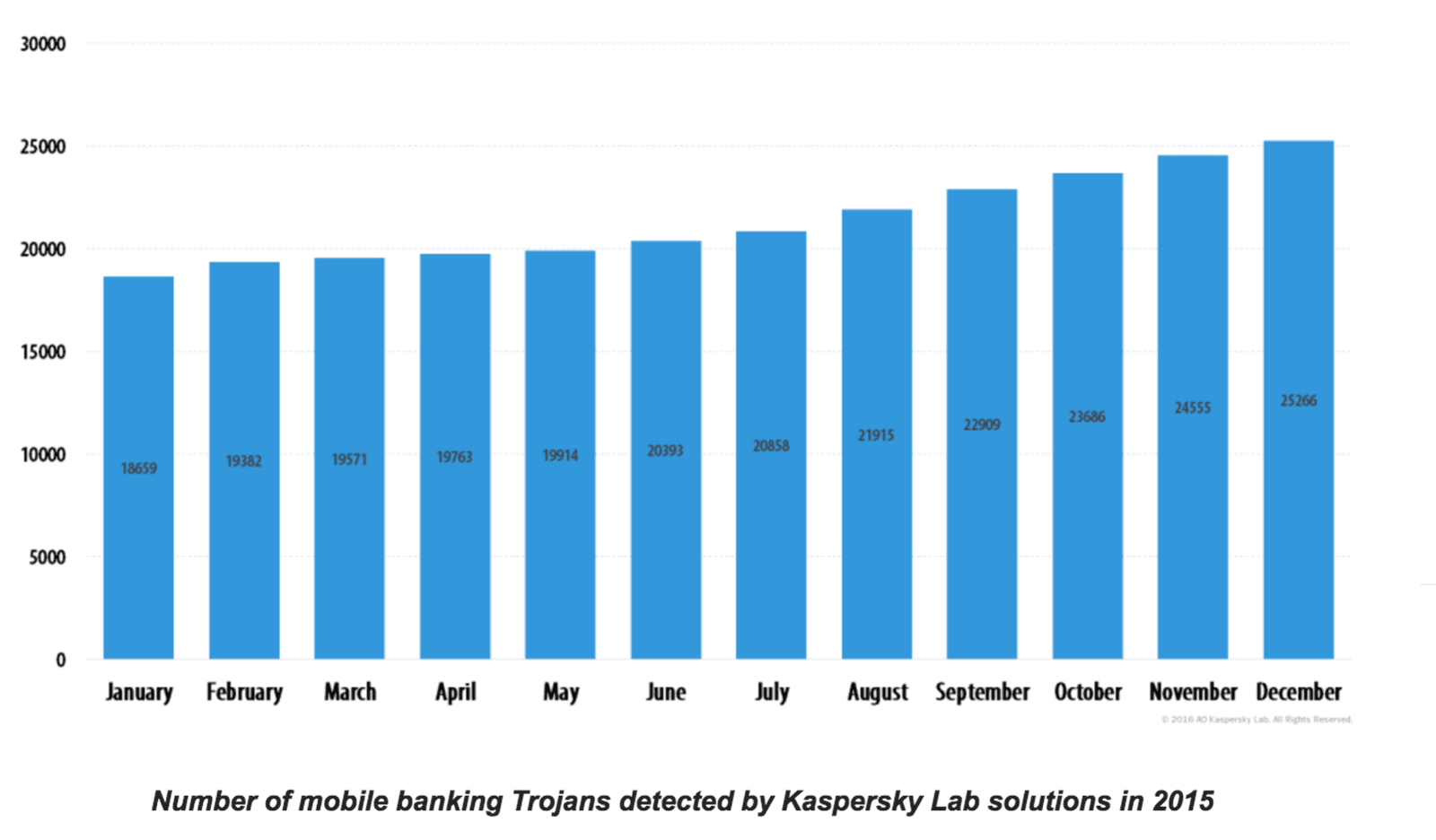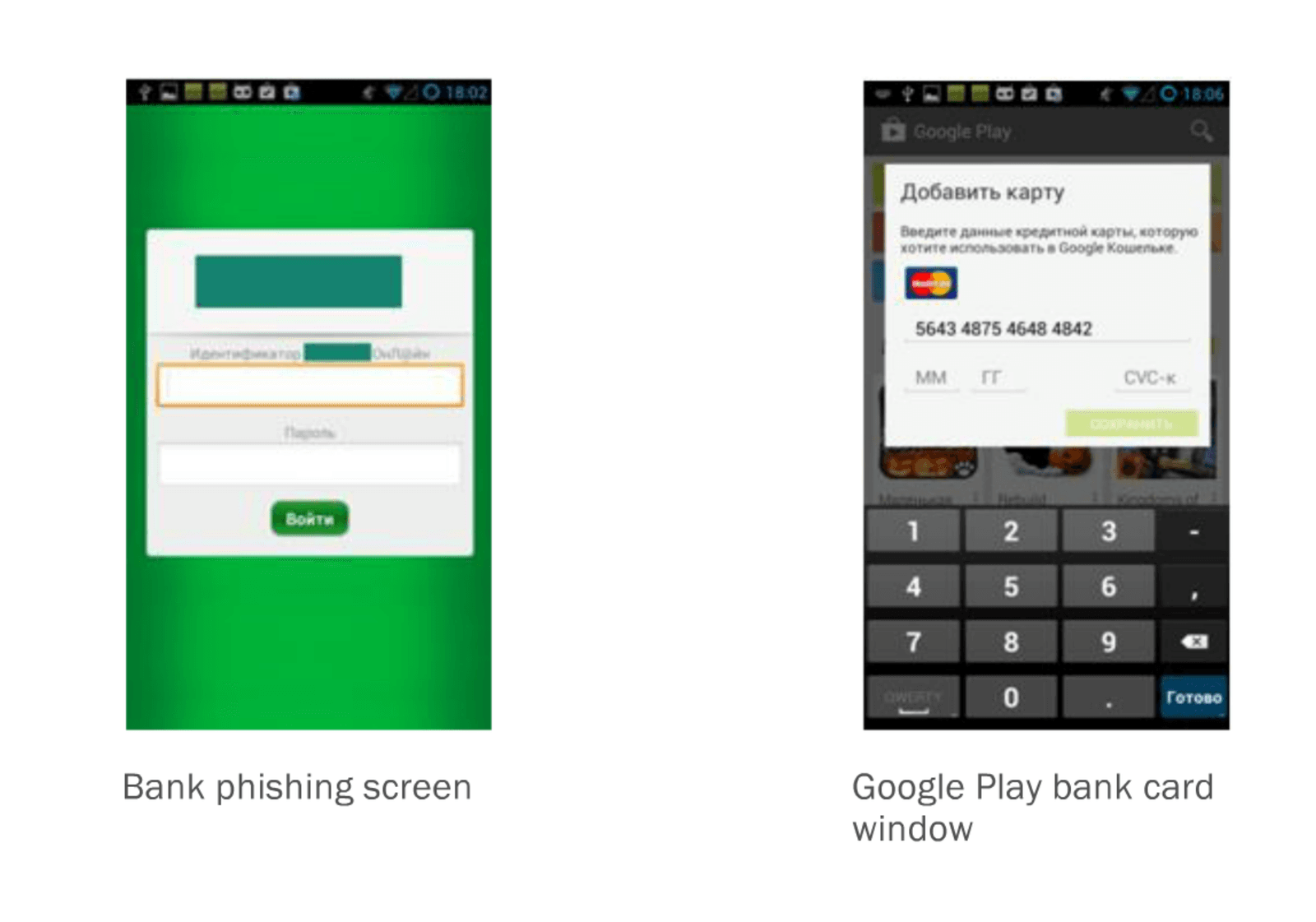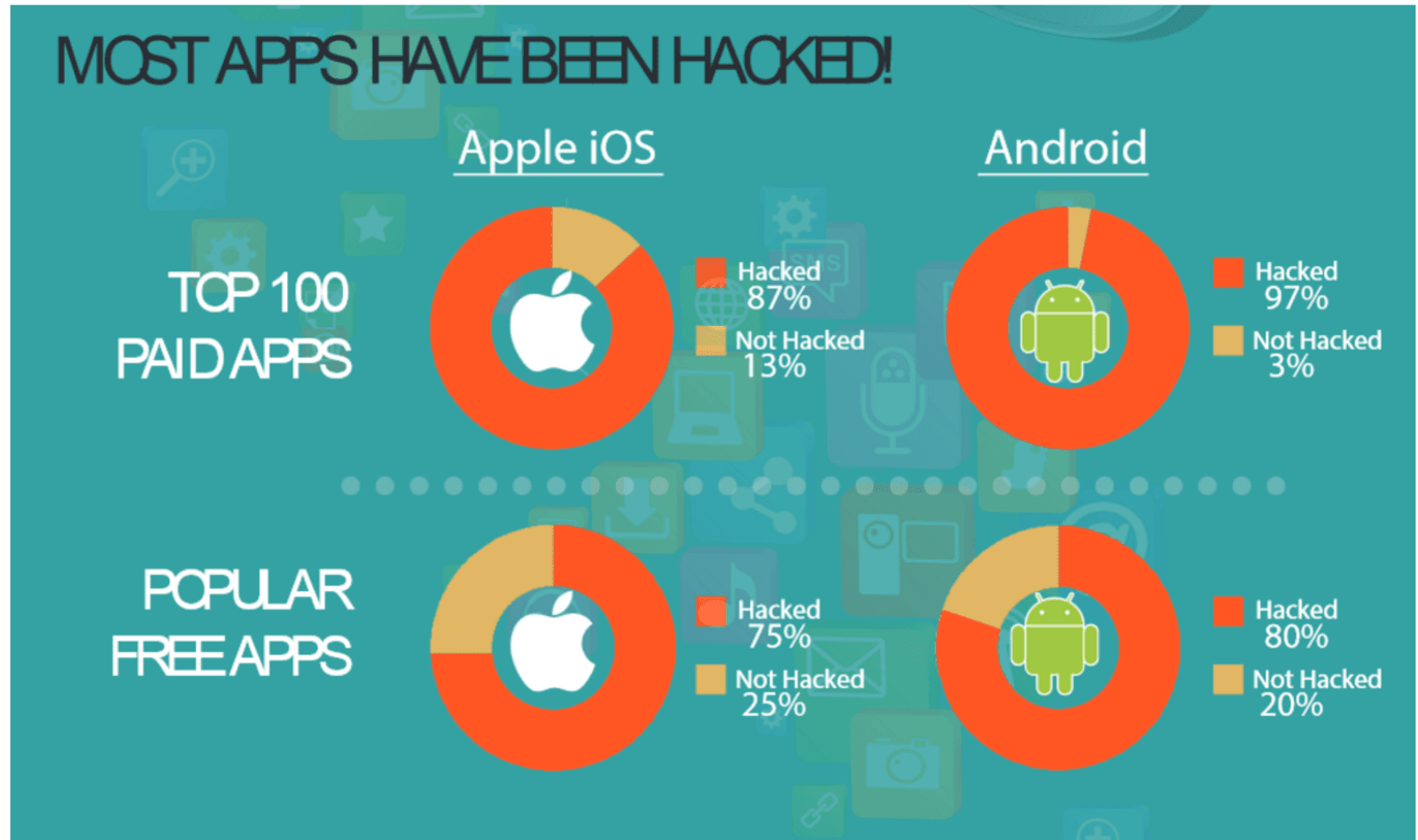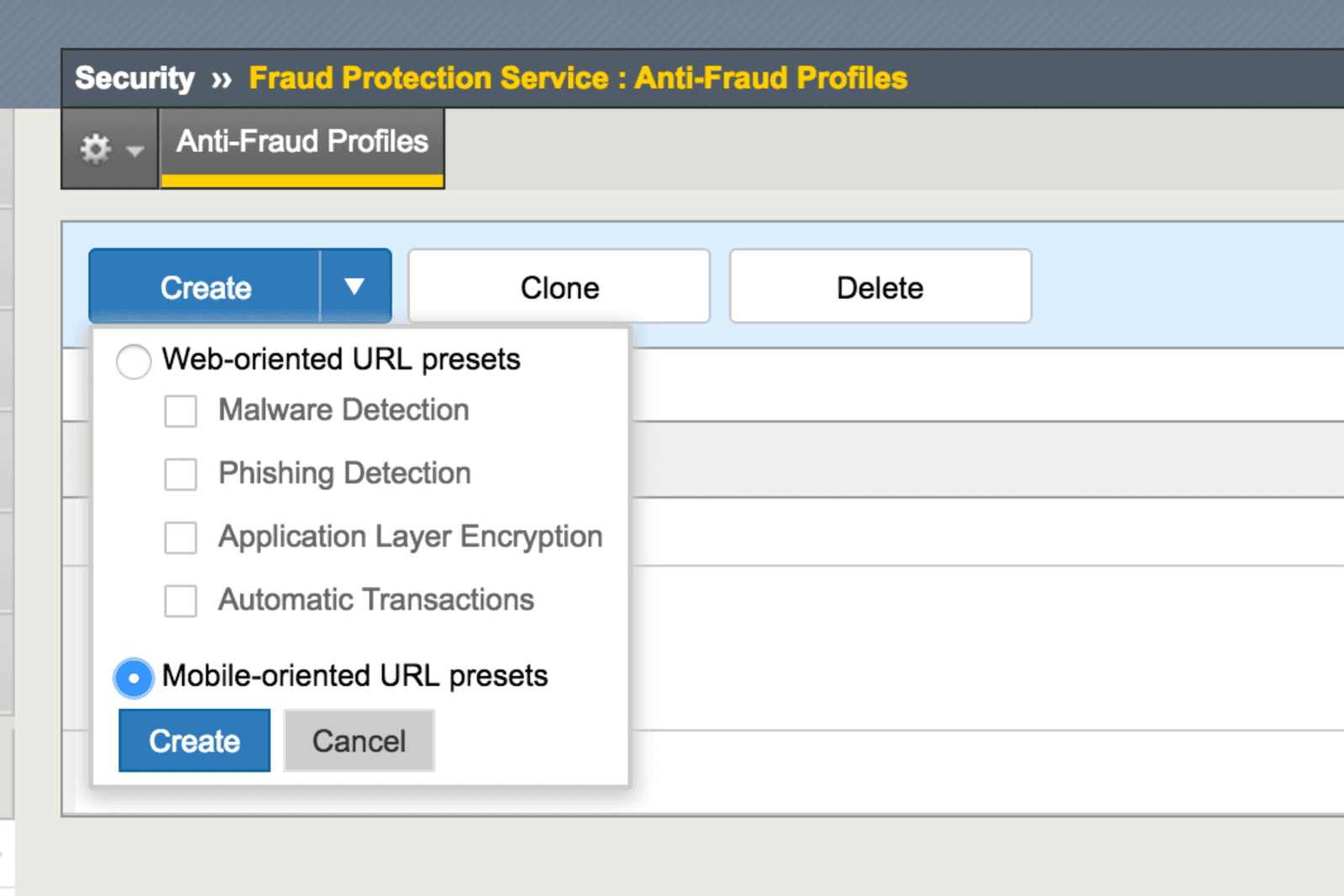Modern Banking with Mobile
Mobile devices are rapidly becoming the instrument of choice for digital users, impacting the financial sector as well. The new generation needs banking to be mobile-friendly. Per the findings of the Federal Reserve, mobile banking usage is at 67% for the age group of 18-to-29. The primary concern for not adopting mobile for banking was security. With mobility being an unstoppable force, organizations need to understand this risk vector to adequately plan for and mitigate threats. This article is directed toward some of the most notable (and exploited) vulnerabilities in the mobile space.
What is Mobile Malware?
As with any malware, mobile malware is a piece of code written to attack a smart phone or similar device. Mobile malware history goes back to at least the year 2000, when the first know mobile malware “TIMOFONICA” was detected by researchers. In 2016, malware like "Godless" that can root up to 90% Android devices are found in the wild.
A quick look at the analytics done by Kaspersky lab shows the number of Mobile Banking Trojans is going up. About 56,194 users were attacked by mobile banking Trojans at least once during the year 2015.

Types: Spyware and Adware, Trojan and Viruses, Phishing Apps etc.
Malware active in the wild can be currently classified as spyware/adware, Trojan and viruses, phishing apps, or bot processes. Their sole intention is to capture valuable personal information and exfiltrate it.
- Spyware and adware disguised as a legitimate app are known to gather user and device information, which can be used for future attacks.
- Trojans hijack devices and send unauthorized premium text SMS. The more prevalent ones have the capability to redraw on user screens and act as legitimate applications to steal confidential information like banking credentials and out of band one-time passwords.
- Phishing Applications leverage rogue or refactored applications to deliver malicious content to the user.
Common Vulnerabilities and Tricks Utilized by Mobile Malware
Mobile devices support multiple platforms like iOS, Android, Windows, etc. With iOS and Android dominating the market, lets take a look at relevant vulnerabilities that are exploited:
- Rooted or Jailbroken Devices: Rooting/Jailbreaking a phone provides root level access to the mobile operating system. While this gives users the capability to modify the stock behavior of the device, this also creates an extreme risk to the applications as the process breaks the security model of the device. A rooted/jailbroken device provides perfect avenue for malware and rogue application to infect and exfiltrate data.
- Man in The Middle Attacks: This attack vector utilizes a third party coming in between the device and server communication, sniffing and altering the payload. With mobile devices, attack vectors are amplified as people tend to connect to free Wi-Fi zones at hotels, coffee shops, and other public places,

Out-of-Date Operating System: This syndrome affects Android user more than iOS users. There is a lot of fragmentation on version of Android devices. Some of the devices might still be running and old version with known vulnerabilities, making it fertile ground for a malware attack.SMS Grabber: Modern day adaptive authentication techniques utilize out of band authentication, and SMS seems to be one of the most popular points of vulnerability. Mobile malware affecting an Android device is capable of stealing a one-time password sent to the device. Android version 4.3 and below enabled the malware to prohibit the SMS from appearing in the inbox making the attack completely silent. In the later version of Android, malware cannot prevent the SMS from appearing in the inbox, alerting users about the unexpected SMS.Focus Stealing: Activity Hijacking or Mobile Phishing exploit the vulnerability in Android in which a malicious activity is launched instead of the expected one. Using a similar-looking display, a user is tricked into providing credentials to the malware. This attack vector is commonly exploited by financial malware. The attack vector affects Android versions less than 5, and in later versions Google has mitigated the attack vectors.

Repackaged applications: Malware authors get legitimate applications and repackage the application with a malicious payload and use spam campaigns, and in some case even upload the application to playstore/appstore for mass distribution. Per a study conducted by Arxan Technologies 80% of popular Android apps and 75% of iOS apps have been hacked:

- Non Jailbroken iOS malware: New variants of malware (example: YiSpecter) have been detected which are able to infect iOS and abuse private APIs.
- And many more...Malware authors are relentlessly inventing and coming up with new techniques to compromise mobile devices.
F5’s Fraud Protection Solution is the Answer
Fraud protection provides organizations with preventive and detective mitigation approaches for modern mobile applications. A range of techniques is used to assess the security integrity of the device; this information is provided to the application and shared with an organization's risk engine to mitigate and remediate threats. Some key features that help overcome these threats include:
- Certificate Forging Detection: Checking the certificate helps prevent against Man in The Middle attacks. The functionality checks for certificate validity against the stored information.
- DNS Spoofing Detection: Defends against Man in the Middle attacks by resolving server names and comparing them against stored information.
- Jailbreak/Rooting Detection: Detects compromised device by checking for root privileges.
- Malware Detection: Looks for indicators of compromise and conducts behavior analysis to find installed malware on the device.
- Unpatched/Unsecure OS detection: SDK is able to compute the Android Version/iOS version and provide the information to an application.
- Focus Stealing Detection: The feature allows application to detect if a rogue application stole focus from the protected application. MobileSafe will generate a broadcast event for the application to respond to this threat.
- Repackaging Detection: For Android apps, the solution will check for the signature to ascertain its authenticity, For iOS, checking for repackaging involves computing MD5 hashes and validating.
Setting Up the Environment
The solution can be set up by enabling F5 MobileSafe on an existing WebSafe environment.
Create/configure a Fraud Protection Solution profile using mobile-oriented presets:

- Once the profile is created, alerts will be available on Alert Server when a user accesses the mobile URLs.
Conclusion
Mobile devices provide users with convenient and easy access to online services, fuelling massive adoption. Hackers are trying to maximize new attack vectors because of the limited understanding of security in this domain. F5’s Fraud Protection Solution provides organization a view into the mobile endpoints and protects against modern and sophisticated threats.
Resources
- F5 Anti-Fraud Solution: https://f5.com/products/modules/websafe
- Mobile Man in the Middle Attack: http://www.information-age.com/technology/security/123461071/what-are-mobile-man-middle-attacks-and-how-dangerous-are-they
About the Author
Related Blog Posts

AppViewX + F5: Automating and orchestrating app delivery
As an F5 ADSP Select partner, AppViewX works with F5 to deliver a centralized orchestration solution to manage app services across distributed environments.

Build a quantum-safe backbone for AI with F5 and NetApp
By deploying F5 and NetApp solutions, enterprises can meet the demands of AI workloads, while preparing for a quantum future.

F5 ADSP Partner Program streamlines adoption of F5 platform
The new F5 ADSP Partner Program creates a dynamic ecosystem that drives growth and success for our partners and customers.
F5 NGINX Gateway Fabric is a certified solution for Red Hat OpenShift
F5 collaborates with Red Hat to deliver a solution that combines the high-performance app delivery of F5 NGINX with Red Hat OpenShift’s enterprise Kubernetes capabilities.
F5 Silverline Mitigates Record-Breaking DDoS Attacks
Malicious attacks are increasing in scale and complexity, threatening to overwhelm and breach the internal resources of businesses globally. Often, these attacks combine high-volume traffic with stealthy, low-and-slow, application-targeted attack techniques, powered by either automated botnets or human-driven tools.
Phishing Attacks Soar 220% During COVID-19 Peak as Cybercriminal Opportunism Intensifies
David Warburton, author of the F5 Labs 2020 Phishing and Fraud Report, describes how fraudsters are adapting to the pandemic and maps out the trends ahead in this video, with summary comments.